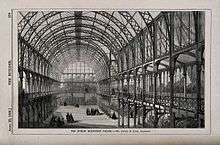International Exhibition of Arts and Manufactures
<table class="infobox" style="width:22em;width:[1]; font-size: 90%;">
International Exhibition of Arts and Manufactures.png)
The International Exhibition of Arts and Manufactures was a world's fair held in Dublin in 1865 attended by almost 1 million visitors.[2]
Site and buildings
In 1862 the Duke of Leinster, Lord Talbot de Malahide and Benjamin Guinness created a Dublin Exhibition Palace and Winter Garden company to establish a Dublin exposition,[3] the first in Dublin since the Great Industrial Exhibition (1853). Guinness supplied the Coburg Gardens, a 15 acre site to the company,[3] which lay between Hatch Street, Harcourt Street and Earlsfort Terrace;[1] and they additionally leased 2 more acres for exhibition grounds.[3]
In 1862 the company called for designs at a cost of 35000 pounds or less. None of the submitted plans came within this cost constraint, but plans from Alfred G Jones were accepted with the proviso that they were revised. In the final design there were three buildings: a brick and stone building, a stone building with iron roof and an iron and glass building, the latter influenced by The Crystal Palace.[3]

The foundations were started in 1863.[4]
The fair
The iron and glass bulding was stress tested by 600 soldiers marching along the galleries on 31 March 1865 and the exhibitioon opened by the then Prince of Wales on either 9 May [4] or 8 May,[5] 1865.
The fair attracted 956000 visitors [2] with averages of 5000 day visitors, and 3000 evening visitors[6]
Displays of fine arts, textiles, manufactured goods and raw materials occupied 4781 display cases (2413 British Isles, 2368 foreign countires, cities and colonies).[7]
Aftermath
The building that lay along Earlsfort Terrace and the winter gardens became part of the city's university[8] and later the building became the National Concert Hall[4] with the winter gardens forming the Iveagh Gardens.[6] A rustic grotto and some statues remain in Iveagh Gardens.[9]
External links
- Engraving showing the main building
- Print of the interior of the Dublin Exhibition Palace and Winter Garden
References
- 1 2 "International Exhibition of Arts and Manufactures, Dublin, 1865 - Mapping the Practice and Profession of Sculpture in Britain and Ireland 1851-1951". Retrieved 2 November 2016.
- 1 2 3 Pelle, Findling, ed. (2008). "Appendix B:Fair Statistics". Encyclopedia of World's Fairs and Expositions. McFarland & Company, Inc. p. 414. ISBN 978-0-7864-3416-9.
- 1 2 3 4 Miglena Ivanova (2008). "Dublin 1865". In Pelle, Findling. Encyclopedia of World's Fairs and Expositions. McFarland & Company, Inc. p. 33. ISBN 978-0-7864-3416-9.
- 1 2 3 Miglena Ivanova (2008). "Dublin 1865". In Pelle, Findling. Encyclopedia of World's Fairs and Expositions. McFarland & Company, Inc. pp. 33–34. ISBN 978-0-7864-3416-9.
- ↑ "Holdings: The International Exhibition, Dublin.". Retrieved 11 April 2016.
- 1 2 "Dublin, June 1865 | Dublin City Council". Retrieved 8 June 2016.
- ↑ Miglena Ivanova (2008). "Dublin 1865". In Pelle, Findling. Encyclopedia of World's Fairs and Expositions. McFarland & Company, Inc. p. 34. ISBN 978-0-7864-3416-9.
- ↑ "Coburg Gardens now Iveagh Gardens | Wide and Convenient Streets". Retrieved 9 June 2016.
- ↑ "1865 - Dublin Exhibition - Architecture of Dublin City, Lost Buildings of Ireland - Archiseek - Irish Architecture". Retrieved November 4, 2016.